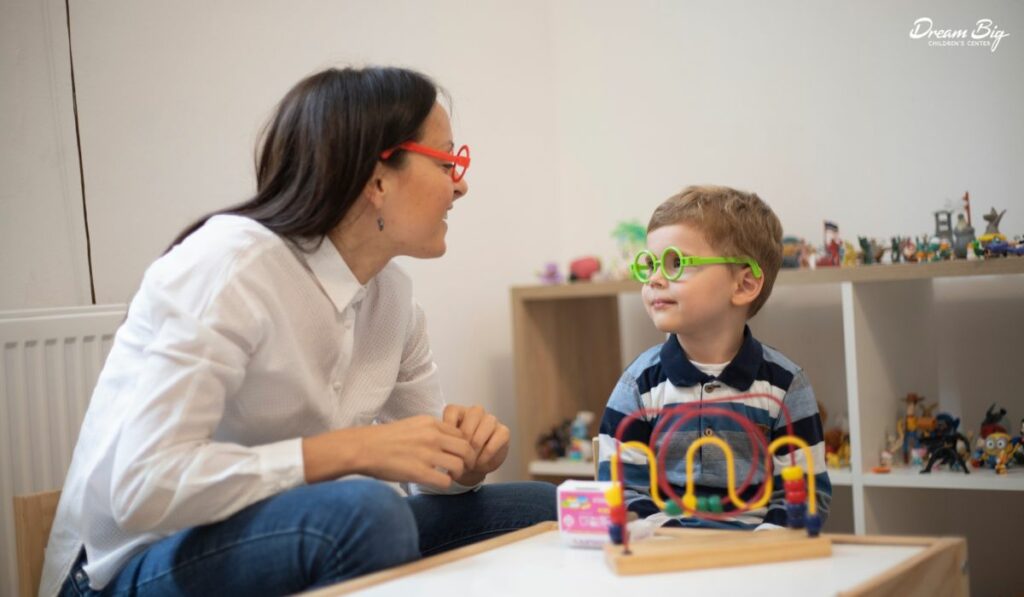Autism Spectrum Disorder (ASD) is a multifaceted neurodevelopmental condition characterized by social communication challenges, repetitive behaviors, and focused interests. Its varied nature creates a spectrum of experiences among individuals. Children diagnosed with autism often encounter obstacles in interacting with others and expressing themselves, posing challenges in conventional therapeutic approaches. In recent years, the integration of play therapy has emerged as an invaluable strategy in supporting these children. This approach provides a distinct and effective means of communication and intervention. Pairing this with specialized ABA services in Apple Valley, CA, offers a tailored and impactful method to address the unique needs of children navigating autism.
Understanding Play Therapy in the Context of Pediatric Autism Healthcare Services
Play therapy is a dynamic and versatile therapeutic approach that utilizes play as a medium for communication and expression. In the realm of pediatric autism healthcare services, play therapy takes on a significant role, offering a tailored and child-centric method to address the unique needs and challenges faced by children on the autism spectrum.
The Essence of Play in Autism Therapy

For children with autism, engaging in play can be a powerful tool for learning social skills, communication, emotional regulation, and cognitive development. Play therapy allows therapists to connect with children on their terms, utilizing their preferred mode of communication, which often involves sensory experiences, visual aids, and structured routines. Through various forms of play, including imaginative, sensory, and structured play, therapists can build rapport, establish trust, and create a safe environment for the child to explore and express themselves.
Tailoring Play Therapy Techniques for Autism Spectrum Disorder
The effectiveness of play therapy in pediatric autism healthcare services lies in its adaptability. Therapists employ various techniques tailored to each child’s unique needs and preferences. Structured and predictable play activities help autistic children navigate and understand social cues and expectations—visual aids, such as social stories and visible schedules, enhance communication and comprehension skills. Sensory-based play activities assist in regulating sensory processing difficulties commonly associated with autism, promoting self-regulation and emotional stability.
The Therapist-Child Relationship in Play Therapy
Central to the success of play therapy in supporting children with autism is the therapeutic relationship between the therapist and the child. Therapists trained in play therapy techniques establish a nurturing and empathetic connection with the child, fostering a safe and non-judgmental space for exploration and expression. This relationship-building process often involves patience, understanding, and a keen awareness of the child’s needs and communication style.
Benefits of Play Therapy for Children with Autism
The integration of play therapy in pediatric autism healthcare services offers a multitude of benefits:
- It enhances social interaction and communication skills by providing a platform for practicing social scenarios and understanding social cues within a controlled environment.
- Play therapy promotes emotional regulation and self-awareness, allowing children to express and process their feelings in a supportive setting.
- It aids in improving sensory integration and motor skills, addressing sensory sensitivities commonly experienced by children with autism.
Challenges and Considerations in Play Therapy for Autism
While play therapy demonstrates promising outcomes in supporting children with autism, it also presents particular challenges. The heterogeneity of autism spectrum disorder means that what works for one child may not necessarily be effective for another. Additionally, accessing qualified and experienced play therapists specialized in working with children on the spectrum can be limited in some regions. The variability in response to different play therapy techniques necessitates a flexible and individualized approach, which may require ongoing assessment and modifications in the therapeutic process.
Integration of Play Therapy into Multidisciplinary Care
In the context of pediatric autism healthcare services, a multidisciplinary approach is often employed, involving collaboration among various professionals such as speech therapists, occupational therapists, psychologists, and educators. Integrating play therapy into this multidisciplinary framework allows for a comprehensive and holistic approach to addressing the diverse needs of children with autism. Collaboration among professionals ensures a coordinated effort to maximize the child’s development and overall well-being.
Future Directions and Conclusion
As research in autism and play therapy continues to evolve, there is a growing recognition of play therapy’s significant role in pediatric autism healthcare services. Future endeavors should focus on expanding access to specialized play therapy services, conducting empirical research to validate its efficacy, and providing ongoing training for healthcare professionals. By recognizing the transformative potential of play therapy, we can further enhance the quality of care and support offered to autistic children, empowering them to reach their full potential and thrive in their unique journey.
Diverse Play Therapy Modalities for Autism Intervention
Play therapy encompasses various modalities, each offering unique benefits for children on the autism spectrum. Therapists utilize techniques tailored to the child’s interests, strengths, and developmental needs. Expressive arts therapy, involving activities such as drawing, painting, and sculpting, provides an avenue for non-verbal expression, allowing children to communicate and process emotions creatively. Additionally, sand tray therapy creates a sensory-rich environment where children use miniature figures and objects to create stories and scenes, aiding in emotional exploration and cognitive development.
Technology-Enhanced Play Interventions
In an era of advancing technology, integrating digital platforms and tools has expanded the scope of play therapy for children with autism. Virtual reality (VR) and augmented reality (AR) applications provide immersive and interactive experiences, offering opportunities for simulated social interactions and skill-building exercises in a controlled environment. These technological interventions complement traditional play therapy methods, engaging children in novel and engaging ways while addressing specific therapeutic goals.
Tailoring Play Interventions to Address Sensory Needs
Sensory processing difficulties are prevalent among autistic children, often leading to challenges in regulating sensory input. Play therapy interventions incorporate sensory-based activities to address these needs effectively. Proprioceptive and vestibular activities, such as swinging, jumping, and proprioceptive input through weighted objects, help regulate sensory processing and enhance body awareness. Sensory integration techniques integrated into play therapy sessions assist children in developing coping strategies to manage sensory sensitivities encountered in their daily lives.
Peer Interaction and Social Skills Development

Facilitating peer interaction and social skills development forms a crucial aspect of play therapy for children with autism. Group play therapy sessions create opportunities for children to engage in structured social interactions, practicing turn-taking, sharing, and cooperative play under the guidance of a trained therapist. These sessions simulate real-world social scenarios, allowing children to learn and apply social skills in a supportive and controlled environment, fostering friendships, and improving social confidence.
Conclusion
In conclusion, play therapy is a beacon of hope and support for children with autism within pediatric healthcare services. Its adaptability, focus on individualized care, and emphasis on the therapeutic relationship make it a valuable asset in addressing the multifaceted needs of children on the autism spectrum. By integrating play therapy into the multidisciplinary approach to autism care, we pave the way for a more inclusive and effective healthcare landscape, ensuring every child receives the support they need to flourish and succeed.
For families seeking specialized play therapy services for their child with autism, consider reaching out to Dream Big Children’s Center. Their team of dedicated professionals provides tailored and comprehensive support, helping children thrive in their unique journey towards growth and development.
FAQs
Q: What is play therapy, and how does it benefit children with autism?
A: Play therapy is a therapeutic approach that utilizes play to communicate and intervene. It offers children with autism a comfortable and engaging way to express themselves, learn social skills, regulate emotions, and develop essential life skills in a supportive environment tailored to their needs.
Q: How does play therapy differ from traditional therapy for children with autism?
A: Unlike traditional therapy, which may rely more on verbal communication, play therapy is child-centered and uses various forms of play as the primary mode of interaction. It caters to the unique communication styles and sensory preferences of children with autism, making therapy sessions more accessible and practical.
Q: What types of play therapy techniques are used in supporting children with autism?
A: Play therapy for children with autism involves diverse techniques, including imaginative play, sensory-based activities, structured play, expressive arts therapy, sand tray therapy, and technology-enhanced interventions like virtual reality (VR) or augmented reality (AR).
Q: How can families be involved in play therapy sessions for their child with autism?
A: Involving families is crucial in reinforcing the skills learned during play therapy. Therapists educate and guide parents and caregivers on implementing strategies at home, creating an environment that supports the child’s continued development and practice of learned skills.
Q: Are there specific qualifications or certifications for therapists providing play therapy for children with autism?
A: Yes, therapists specializing in play therapy for autism typically have certifications or training in play therapy techniques and additional qualifications in working with children on the autism spectrum. Credentials might include Registered Play Therapist (RPT) or specialized Applied Behavior Analysis (ABA) training. Dream Big Children’s Center provides welcoming, play-based environments with inclusive playgroups for both learning and fun. Additionally, our ABA Therapy incorporates play therapy to cater specifically to the needs of children with autism.
Q: How can play therapy help children with sensory processing difficulties associated with autism?
A: Play therapy incorporates sensory-based activities tailored to address sensory sensitivities. Proprioceptive and vestibular activities and sensory integration techniques help children regulate sensory input, improving sensory processing and enhancing their ability to navigate sensory challenges.
Q: Is play therapy for autism covered by insurance or healthcare plans?
A: Coverage for play therapy services for children with autism may vary depending on the insurance provider and specific policy terms. Some insurance plans may cover certain aspects of therapy, while others may require out-of-pocket expenses or specialized autism-related coverage. It’s advisable to check with the insurance provider for specific coverage details.


